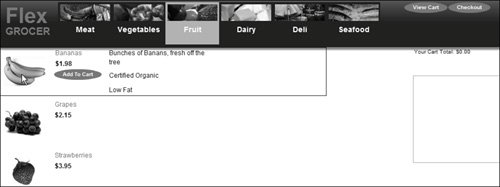Lesson 22. Creating Transitions and Behaviors
You can apply dynamic effects to your application using behaviors and transitions that can include animation and/or sounds. These effects can be based on application or user triggers, which cause behavior or transition to occur. Content is the most important consideration, but animations and sound can also greatly enhance the user experienceespecially in dynamic presentation interfaces. Behaviors are dynamic effects that can be applied directly to Flex components, whereas transitions are dynamic effects applied to view states. Animations can often enhance the user's experience when navigating throughout an application. In this lesson, you will modify the FlexGrocer application so that the transitions between states are smoother and components are displayed using a fade-in effect. Grocery item details will be displayed using a WipeRight transition.  |
EAN: 2147483647
Pages: 225